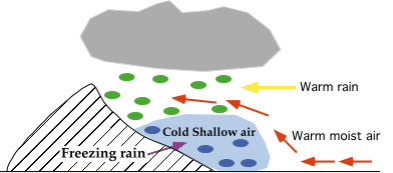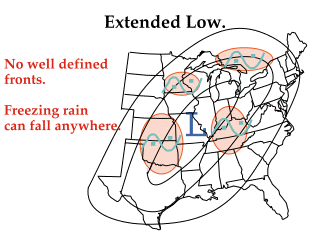|
|
. |
Cold-Air Damming and Extended Lows
their roles in the development of freezing rain
Cold-air damming is common along the East Coast of the United States
and occurs when a layer of cold air gets trapped between the coast and inland
mountains. Freezing rain develops when
warm oceanic air rises up and over the
cold air, producing
liquid precipitation that falls through the cold layer. The falling
droplets become supercooled
and freeze on impact with the cold surface.

Another weather pattern that may lead to the development of
freezing rain is a broad area
of low pressure called an "extended low",
which is typically very weak
and covers a large
area of the country. An extended low has very diffuse
frontal boundaries and is often the remnants of
a dying cyclone.

Upper-level winds transport warm moist air up and over the pool
of cold air associated with the extended low, and given the right conditions,
freezing rain occurs. In addition,
convergence associated with the low
produces upward motions that may also contribute to the
development of freezing rain.
Freezing rain can be found anywhere in the vicinity of an extended low since
there are typically no preferred regions of development.

pressure features
|
|

Forecasting
|
|



